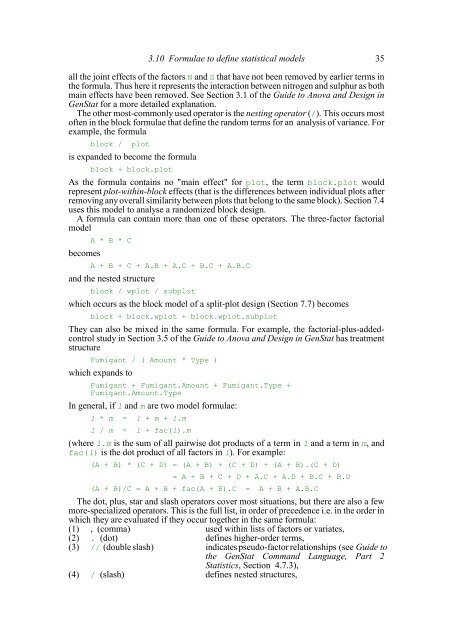Download pdf guide - VSN International
Download pdf guide - VSN International
Download pdf guide - VSN International
- No tags were found...
You also want an ePaper? Increase the reach of your titles
YUMPU automatically turns print PDFs into web optimized ePapers that Google loves.
3.10 Formulae to define statistical models 35all the joint effects of the factors N and S that have not been removed by earlier terms inthe formula. Thus here it represents the interaction between nitrogen and sulphur as bothmain effects have been removed. See Section 3.1 of the Guide to Anova and Design inGenStat for a more detailed explanation.The other most-commonly used operator is the nesting operator (/). This occurs mostoften in the block formulae that define the random terms for an analysis of variance. Forexample, the formulablock / plotis expanded to become the formulablock + block.plotAs the formula contains no "main effect" for plot, the term block.plot wouldrepresent plot-within-block effects (that is the differences between individual plots afterremoving any overall similarity between plots that belong to the same block). Section 7.4uses this model to analyse a randomized block design.A formula can contain more than one of these operators. The three-factor factorialmodelbecomesA * B * CA + B + C + A.B + A.C + B.C + A.B.Cand the nested structureblock / wplot / subplotwhich occurs as the block model of a split-plot design (Section 7.7) becomesblock + block.wplot + block.wplot.subplotThey can also be mixed in the same formula. For example, the factorial-plus-addedcontrolstudy in Section 3.5 of the Guide to Anova and Design in GenStat has treatmentstructureFumigant / ( Amount * Type )which expands toFumigant + Fumigant.Amount + Fumigant.Type +Fumigant.Amount.TypeIn general, if l and m are two model formulae:l * m = l + m + l.ml / m = l + fac(l).m(where l.m is the sum of all pairwise dot products of a term in l and a term in m, andfac(l) is the dot product of all factors in l). For example:(A + B) * (C + D) = (A + B) + (C + D) + (A + B).(C + D)= A + B + C + D + A.C + A.D + B.C + B.D(A + B)/C = A + B + fac(A + B).C = A + B + A.B.CThe dot, plus, star and slash operators cover most situations, but there are also a fewmore-specialized operators. This is the full list, in order of precedence i.e. in the order inwhich they are evaluated if they occur together in the same formula:(1) , (comma) used within lists of factors or variates,(2) . (dot) defines higher-order terms,(3) // (double slash) indicates pseudo-factor relationships (see Guide tothe GenStat Command Language, Part 2Statistics, Section 4.7.3),(4) / (slash) defines nested structures,
















